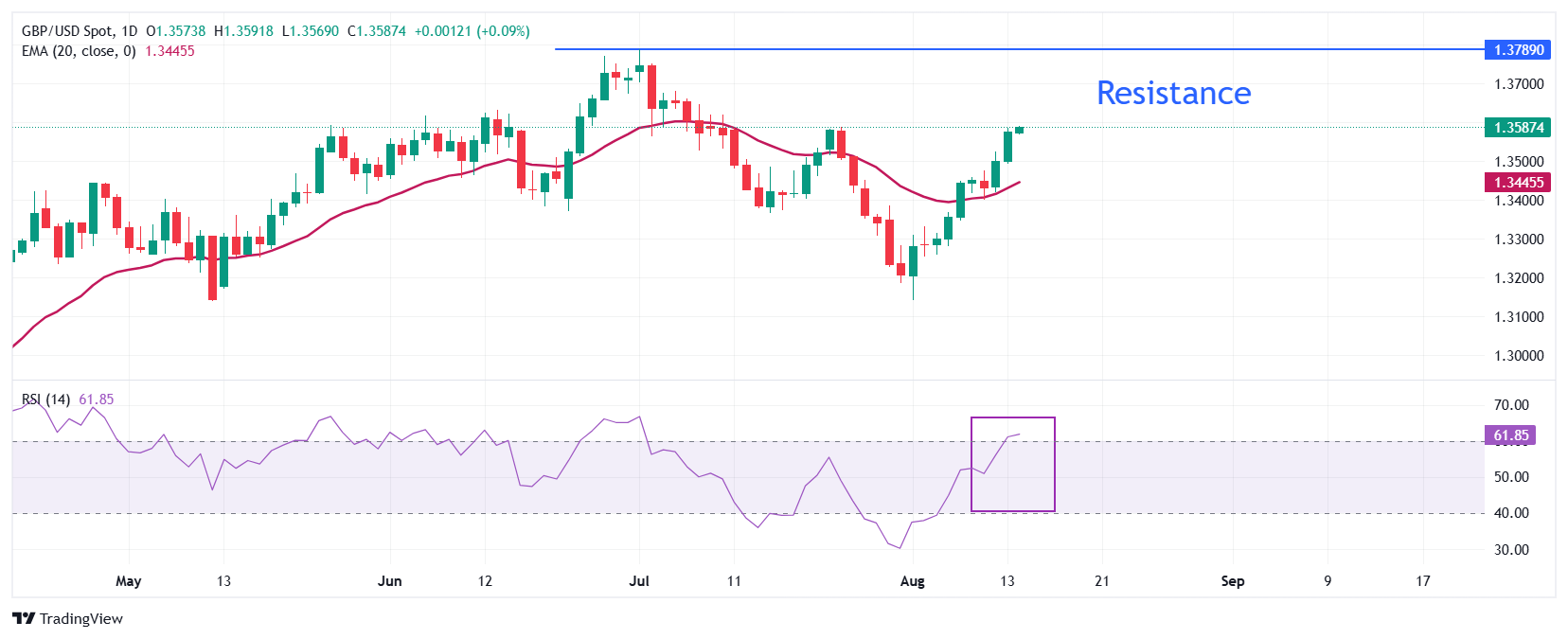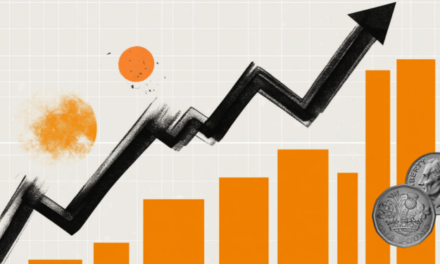- The Pound Sterling gains against its peers as the UK GDP grew more than expected in June and in the overall Q2.
- The UK’s factory sector returned to expansion after contracting significantly in May.
- US Treasury Secretary Bessent said he supports a larger interest-rate reduction by the Fed in September.
The Pound Sterling (GBP) attracts bids against its major peers on Thursday on upbeat United Kingdom (UK) Gross Domestic Product (GDP) and factory data. The Office for National Statistics (ONS) reported that the economy grew by 0.3% in the second quarter of the year, stronger than expectations of 0.1%. In the first quarter of the year, GDP growth was 0.7%.
In June, the UK economy grew by 0.4% after contracting 0.1% in May, while it was expected to rise just by 0.1%.
Factory data has also come in stronger than projected. Month-on-month, Manufacturing and Industrial Production rose by 0.5% and 0.7% in June, respectively, after declining significantly in May.
Upbeat GDP and factory data show that the economy is holding up better than anticipated, a scenario that could allow the Bank of England (BoE) to avoid reducing interest rates aggressively, and thus be supportive for the Pound Sterling.
In the monetary policy meeting earlier this month, the BoE reduced interest rates by 25 basis points (bps) to 4.00% and retained its “gradual and careful” monetary expansion guidance. Still, it was a very tight decision as four of the nine BoE members voted to keep rates unchanged.
British Pound PRICE Today
The table below shows the percentage change of British Pound (GBP) against listed major currencies today. British Pound was the strongest against the New Zealand Dollar.
| USD | EUR | GBP | JPY | CAD | AUD | NZD | CHF | |
|---|---|---|---|---|---|---|---|---|
| USD | 0.30% | 0.00% | -0.56% | 0.17% | 0.26% | 0.48% | 0.21% | |
| EUR | -0.30% | -0.26% | -0.84% | -0.14% | -0.03% | 0.16% | -0.10% | |
| GBP | -0.01% | 0.26% | -0.60% | 0.22% | 0.29% | 0.53% | 0.27% | |
| JPY | 0.56% | 0.84% | 0.60% | 0.75% | 0.81% | 0.92% | 0.72% | |
| CAD | -0.17% | 0.14% | -0.22% | -0.75% | 0.13% | 0.30% | 0.05% | |
| AUD | -0.26% | 0.03% | -0.29% | -0.81% | -0.13% | 0.24% | -0.11% | |
| NZD | -0.48% | -0.16% | -0.53% | -0.92% | -0.30% | -0.24% | -0.30% | |
| CHF | -0.21% | 0.10% | -0.27% | -0.72% | -0.05% | 0.11% | 0.30% |
The heat map shows percentage changes of major currencies against each other. The base currency is picked from the left column, while the quote currency is picked from the top row. For example, if you pick the British Pound from the left column and move along the horizontal line to the US Dollar, the percentage change displayed in the box will represent GBP (base)/USD (quote).
Daily digest market movers: Pound Sterling refreshes monthly high against US Dollar
- The Pound Sterling jumps to near 1.3600 against the US Dollar (USD) during the European trading session on Thursday after the release of the UK GDP data.
- The US Dollar faces selling pressure as traders have become increasingly confident that the Federal Reserve (Fed) will reduce interest rates in the monetary policy meeting in September. At the time of writing, the US Dollar Index (DXY), which tracks the Greenback’s value against six major currencies, trades vulnerably near the two-week low around 97.60.
- According to the CME FedWatch tool, traders have almost fully priced in a 25 basis points (bps) interest rate reduction in September that would push borrowing rates lower to 4.00-4.25%.
- Fed interest rate cut expectations have intensified due to cooling labor market conditions and evidence of little impact from tariffs on inflation in the latest Consumer Price Index (CPI) report.
- The US Nonfarm Payrolls (NFP) report showed earlier this month that new jobs created in July were lower than projected, and data for May and June were revised significantly lower. Meanwhile, the CPI report showed on Tuesday that the headline inflation grew at a moderate pace of 0.2% on a month, as expected, slower than the prior reading of 0.3%. The CPI report didn’t show any significant signs that the impact of tariffs is feeding into prices.
- On Wednesday, US Treasury Secretary Scott Bessent said, in an interview with Bloomberg TV, that the Fed should follow an aggressive monetary easing, citing labor market concerns. Bessent projected a “series of interest rate cuts” from the Fed and stated that the central bank could deliver a larger, 50-basis points reduction in the September meeting. “Rates are too constrictive. We should probably be 150 to 175 basis points lower,” Bessent said.
- In Thursday’s session, investors will focus on the US Producer Price Index (PPI) data for July, which will be published at 12:30 GMT. Month-on-month, headline and core PPI are estimated to have risen by 0.2%, after remaining flat in June. On year, the headline and the core PPI are expected to have grown at a faster pace of 2.5% and 2.9%, respectively.
Technical Analysis: Pound Sterling stays above 20-day EMA

The Pound Sterling advances to near 1.3600 against the US Dollar on Thursday, the highest level seen in a month. The near-term trend of the GBP/USD pair remains bullish as it holds the 20-day Exponential Moving Average (EMA), which trades around 1.3445.
The 14-day Relative Strength Index (RSI) breaks above 60.00. A fresh bullish momentum would emerge if the RSI holds above that level.
Looking down, the August 11 low of 1.3400 will act as a key support zone. On the upside, the July 1 high near 1.3790 will act as a key barrier.
GDP FAQs
A country’s Gross Domestic Product (GDP) measures the rate of growth of its economy over a given period of time, usually a quarter. The most reliable figures are those that compare GDP to the previous quarter e.g Q2 of 2023 vs Q1 of 2023, or to the same period in the previous year, e.g Q2 of 2023 vs Q2 of 2022.
Annualized quarterly GDP figures extrapolate the growth rate of the quarter as if it were constant for the rest of the year. These can be misleading, however, if temporary shocks impact growth in one quarter but are unlikely to last all year – such as happened in the first quarter of 2020 at the outbreak of the covid pandemic, when growth plummeted.
A higher GDP result is generally positive for a nation’s currency as it reflects a growing economy, which is more likely to produce goods and services that can be exported, as well as attracting higher foreign investment. By the same token, when GDP falls it is usually negative for the currency.
When an economy grows people tend to spend more, which leads to inflation. The country’s central bank then has to put up interest rates to combat the inflation with the side effect of attracting more capital inflows from global investors, thus helping the local currency appreciate.
When an economy grows and GDP is rising, people tend to spend more which leads to inflation. The country’s central bank then has to put up interest rates to combat the inflation. Higher interest rates are negative for Gold because they increase the opportunity-cost of holding Gold versus placing the money in a cash deposit account. Therefore, a higher GDP growth rate is usually a bearish factor for Gold price.







